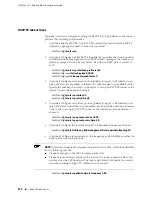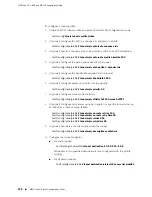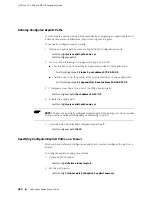
Controlling LDP Label Distribution
By default, LDP advertises label mappings for all IGP prefixes to all LDP peers. In
this case, mappings are not advertised for interface addresses. You can alternatively
specify that LDP labels be distributed for a particular interface itself, in addition to
the subnet that the interface is on. This behavior enables LSPs to be set up to the
LSR configured with the interface address.
When the LSR learns an IGP route and tries to decide whether to advertise a label
for the destination to a particular LDP neighbor, it attempts to match the destination
against a route access list specified by the
mpls ldp advertise-labels
command, in
the order in which the commands were issued. The first match determines the action
taken, and no further matching is attempted for that destination. If the destination
matches, labels are advertised to peers subject to any specified neighbor address
list. If either access list is not matched, the labels are not advertised.
To create a filter that determines whether and where incoming (locally assigned)
labels are distributed:
■
Issue the mpls ldp advertise-labels command one or more times:
host1(config)#
mpls ldp advertise-labels for net25 to euro3
When you do not specify a
toAccessList
, the action is taken for all peers.
Consider the following example configuration.
host1(config)#
mpls ldp advertise-labels for net25 to euro3
host1(config)#
mpls ldp advertise-labels for boston1
In this example, suppose the LSR receives a label for destination 10.10.11.12. If
net25 specifies 10.10.11.12, then the access list action—permit or deny—is taken
with the destination. If the action is permit, the peer that the label is advertised to
is subject to the access list euro3. If net25 does not include 10.10.11.12, the LSR
attempts to match it against boston1. If 10.10.11.12 is present in that access list,
the specified action is taken for all peers. If boston1 does not include the destination,
the label is not advertised to any peer.
Related Topics
Basic MPLS Configuration Tasks on page 268
■
■
Additional LDP Configuration Tasks on page 281
■
mpls ldp advertise-labels
Additional RSVP-TE Configuration Tasks
All of the following RSVP-TE configuration tasks are optional, depending on your
network topology and needs.
Tasks to configure RSVP-TE settings based on your network topology include:
286
■
Controlling LDP Label Distribution
JUNOSe 11.1.x BGP and MPLS Configuration Guide
Summary of Contents for BGP
Page 6: ...vi ...
Page 8: ...viii JUNOSe 11 1 x BGP and MPLS Configuration Guide ...
Page 37: ...Part 1 Border Gateway Protocol Configuring BGP Routing on page 3 Border Gateway Protocol 1 ...
Page 38: ...2 Border Gateway Protocol JUNOSe 11 1 x BGP and MPLS Configuration Guide ...
Page 234: ...198 Monitoring BGP JUNOSe 11 1 x BGP and MPLS Configuration Guide ...
Page 236: ...200 Multiprotocol Layer Switching JUNOSe 11 1 x BGP and MPLS Configuration Guide ...
Page 542: ...506 Monitoring BGP MPLS VPNs JUNOSe 11 1 x BGP and MPLS Configuration Guide ...
Page 544: ...508 Layer 2 Services Over MPLS JUNOSe 11 1 x BGP and MPLS Configuration Guide ...
Page 610: ...574 Virtual Private LAN Service JUNOSe 11 1 x BGP and MPLS Configuration Guide ...
Page 624: ...588 VPLS References JUNOSe 11 1 x BGP and MPLS Configuration Guide ...
Page 680: ...644 Virtual Private Wire Service JUNOSe 11 1 x BGP and MPLS Configuration Guide ...
Page 724: ...688 Monitoring MPLS Forwarding Table for VPWS JUNOSe 11 1 x BGP and MPLS Configuration Guide ...
Page 725: ...Part 6 Index Index on page 691 Index 689 ...
Page 726: ...690 Index JUNOSe 11 1 x BGP and MPLS Configuration Guide ...
















































